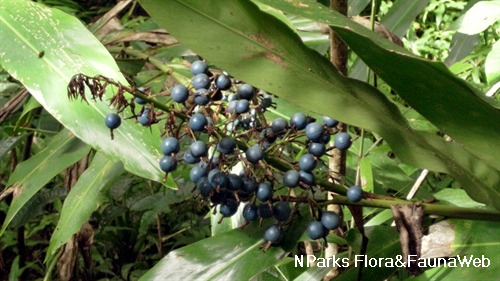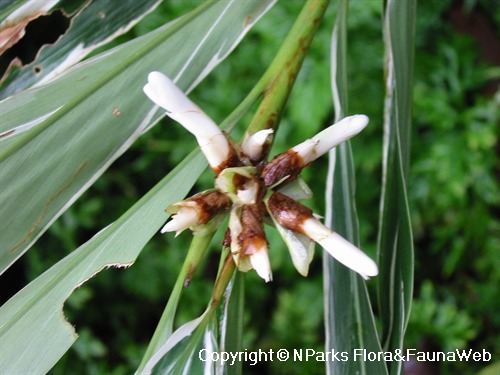
Back
Alpinia caerulea (R.Br.) Benth.
| Family Name: | Zingiberaceae |
| Common Name: | Native Ginger, Blue Fruited Ginger, Australian Blue Ginger, Red Back Australian Ginger |
Name
Classifications and Characteristics
| Plant Division | Angiosperms (Flowering Seed Plants) (Monocotyledon) |
|---|---|
| Plant Growth Form | Herbaceous Plant |
| Lifespan (in Singapore) | Perennial |
| Mode of Nutrition | Autotrophic |
| Maximum Height | 2 m to 3 m |
| Maximum Plant Spread / Crown Width | 1 m to 2 m |
Biogeography
| Native Distribution | Papua New Guinea, Australia (East Queensland to North East New South Wales) |
|---|---|
| Native Habitat | Terrestrial |
| Preferred Climate Zone | Tropical, Sub-Tropical / Monsoonal |
| Local Conservation Status | Non-native (Horticultural / Cultivated Only) |
Description and Ethnobotany
| Growth Form | It is a rhizomatous herb, which can grow up to 2-3 m tall. |
|---|---|
| Foliage | Its leaves are dark-green and broad-lanceolate shaped. The leaf sheaths wrap tightly together. |
| Flowers | The inflorescence is a spike, upright and consists of many small white flowers. |
| Fruit | Round, blue fruit is a capsule (1 cm wide). |
| Ethnobotanical Uses | Edible Plant Parts : Edible Stems, Edible Roots Food (Fruit or Vegetable): The fruit pulp was eaten by aboriginal Australians who discarded the seed. <1> Some sources indicate that the seed should not be eaten. (Herb or Spice): The stem and rhizome (underground horizontal stem) has a mild ginger flavour and can be used as a ginger substitute. Medicinal: Scientific Evidence of Medicinal Properties Based on research on the effect of Native Ginger on animals, the fruit extract may have compounds that inhibit creation of new blood vessels which could be therapeutic in diseases caused by excess vessel formation <1>. The leaf extract may inhibit growth of disease-causing bacteria <2>. |
Landscaping Features
| Desirable Plant Features | Ornamental Fruits, Fragrant (Flowers) |
|---|---|
| Landscape Uses | Parks & Gardens, Small Gardens, Interiorscape/ Indoor Plant, Container Planting |
| Thematic Landscaping | Economic Garden |
Fauna, Pollination and Dispersal
| Pollination Method(s) | Biotic (Fauna) |
|---|---|
| Seed or Spore Dispersal | Biotic (Fauna) |
Plant Care and Propagation
| Light Preference | Semi-Shade |
|---|---|
| Water Preference | Lots of Water, Moderate Water, Occasional Misting |
| Plant Growth Rate | Moderate |
| Rootzone Tolerance | Moist Soils, Fertile Loamy Soils |
| Propagation Method | Seed, Division |
Foliar
| Foliage Retention | Evergreen |
|---|---|
| Mature Foliage Colour(s) | Green, Red |
| Mature Foliage Texture(s) | Smooth |
| Foliar Type | Simple / Unifoliate |
| Foliar Arrangement Along Stem | Alternate |
| Foliar Attachment to Stem | Sessile |
| Foliar Shape(s) | Non-Palm Foliage (Lanceolate, Oblong) |
| Foliar Margin | Entire - Wavy / Undulate |
| Foliar Apex - Tip | Acuminate |
| Foliar Base | Clasping |
| Typical Foliar Area | Macrophyll ( 182.25cm2 - 1640.25 cm2 ) |
Floral (Angiosperm)
| Flower & Plant Sexuality | Bisexual Flowers |
| Flower Colour(s) | White |
|---|---|
| Flower Grouping | Cluster / Inflorescence |
| Flower Location | Terminal |
| Flower Symmetry | Asymmetrical |
| Inflorescence Type | Spike |
| Inflorescence Size | 30 cm x 8 cm |
Fruit, Seed and Spore
| Mature Fruit Colour(s) | Blue |
|---|---|
| Mature Fruit Texture(s) | Smooth |
| Fruit Classification | Simple Fruit |
| Fruit Type | |
| Mature Seed Colour(s) | Black |
References
| References | <1> He, Z.H., Gilli, C., Yue, G.G.L., Lau, C.B.S., Greger, H., Brecker, L., Ge, W., But, P.P.H. (2012). Anti-angiogenic effects and mechanisms of zerumin A from Alpinia caerulea. Food Chemistry 132(1): 201-208. <2> Mpala, L.N., Chikowe, G.R. & Cock, I.E. (2018). Alpinia caerulea (R.Br.) Benth Leaf Extracts Inhibit the Growth of a Panel of Bacterial Pathogens. Pharmacognosy Communication 8(4): 146-152. |
|---|
Image Repository
Others
| Master ID | 31315 |
|---|---|
| Species ID | 5712 |
| Flora Disclaimer | The information in this website has been compiled from reliable sources, such as reference works on medicinal plants. It is not a substitute for medical advice or treatment and NParks does not purport to provide any medical advice. Readers should always consult his/her physician before using or consuming a plant for medicinal purposes. |



.jpg)
